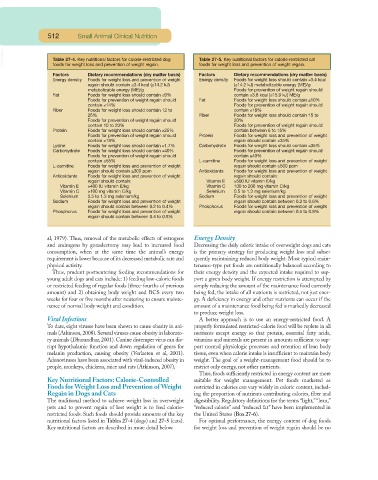Page 496 - Small Animal Clinical Nutrition 5th Edition
P. 496
512 Small Animal Clinical Nutrition
VetBooks.ir Table 27-4. Key nutritional factors for calorie-restricted dog Table 27-5. Key nutritional factors for calorie-restricted cat
foods for weight loss and prevention of weight regain.
foods for weight loss and prevention of weight regain.
Factors Dietary recommendations (dry matter basis) Factors Dietary recommendations (dry matter basis)
Energy density Foods for weight loss and prevention of weight Energy density Foods for weight loss should contain ≤3.4 kcal
regain should contain ≤3.4 kcal (≤14.2 kJ) (≤14.2 kJ) metabolizable energy (ME)/g
metabolizable energy (ME)/g Foods for prevention of weight regain should
Fat Foods for weight loss should contain ≤9% contain ≤3.8 kcal (≤15.9 kJ) ME/g
Foods for prevention of weight regain should Fat Foods for weight loss should contain ≤10%
contain ≤14% Foods for prevention of weight regain should
Fiber Foods for weight loss should contain 12 to contain ≤18%
25% Fiber Foods for weight loss should contain 15 to
Foods for prevention of weight regain should 20%
contain 10 to 20% Foods for prevention of weight regain should
Protein Foods for weight loss should contain ≥25% contain between 6 to 15%
Foods for prevention of weight regain should Protein Foods for weight loss and prevention of weight
contain ≥18% regain should contain ≥35%
Lysine Foods for weight loss should contain ≥1.7% Carbohydrate Foods for weight loss should contain ≤35%
Carbohydrate Foods for weight loss should contain ≤40% Foods for prevention of weight regain should
Foods for prevention of weight regain should contain ≤40%
contain ≤55% L-carnitine Foods for weight loss and prevention of weight
L-carnitine Foods for weight loss and prevention of weight regain should contain ≥500 ppm
regain should contain ≥300 ppm Antioxidants Foods for weight loss and prevention of weight
Antioxidants Foods for weight loss and prevention of weight regain should contain:
regain should contain: Vitamin E ≥500 IU vitamin E/kg
Vitamin E ≥400 IU vitamin E/kg Vitamin C 100 to 200 mg vitamin C/kg
Vitamin C ≥100 mg vitamin C/kg Selenium 0.5 to 1.3 mg selenium/kg
Selenium 0.5 to 1.3 mg selenium/kg Sodium Foods for weight loss and prevention of weight
Sodium Foods for weight loss and prevention of weight regain should contain between 0.2 to 0.6%
regain should contain between 0.2 to 0.4% Phosphorus Foods for weight loss and prevention of weight
Phosphorus Foods for weight loss and prevention of weight regain should contain between 0.5 to 0.8%
regain should contain between 0.4 to 0.8%
al, 1979). Thus, removal of the metabolic effects of estrogens Energy Density
and androgens by gonadectomy may lead to increased food Decreasing the daily caloric intake of overweight dogs and cats
consumption, when at the same time the animal’s energy is the primary strategy for producing weight loss and subse-
requirement is lower because of its decreased metabolic rate and quently maintaining reduced body weight. Most typical main-
physical activity. tenance-type pet foods are nutritionally balanced according to
Thus, prudent postneutering feeding recommendations for their energy density and the expected intake required to sup-
young adult dogs and cats include: 1) feeding low-calorie foods port a given body weight. If energy restriction is attempted by
or restricted feeding of regular foods (three-fourths of previous simply reducing the amount of the maintenance food currently
amount) and 2) obtaining body weight and BCS every two being fed, the intake of all nutrients is restricted, not just ener-
weeks for four or five months after neutering to ensure mainte- gy. A deficiency in energy and other nutrients can occur if the
nance of normal body weight and condition. amount of a maintenance food being fed is markedly decreased
to produce weight loss.
Viral Infections A better approach is to use an energy-restricted food. A
To date, eight viruses have been shown to cause obesity in ani- properly formulated restricted-calorie food will be replete in all
mals (Atkinson, 2008). Several viruses cause obesity in laborato- nutrients except energy so that protein, essential fatty acids,
ry animals (Dhurandhar, 2001). Canine distemper virus can dis- vitamins and minerals are present in amounts sufficient to sup-
rupt hypothalamic function and down regulation of genes for port normal physiologic processes and retention of lean body
melanin production, causing obesity (Verlaeten et al, 2001). tissue, even when calorie intake is insufficient to maintain body
Adenoviruses have been associated with viral-induced obesity in weight. The goal of a weight-management food should be to
people, monkeys, chickens, mice and rats (Atkinson, 2007). restrict only energy, not other nutrients.
Thus, foods sufficiently restricted in energy content are more
Key Nutritional Factors: Calorie-Controlled suitable for weight management. Pet foods marketed as
Foods for Weight Loss and Prevention of Weight restricted in calories can vary widely in caloric content, includ-
Regain in Dogs and Cats ing the proportion of nutrients contributing calories, fiber and
The traditional method to achieve weight loss in overweight digestibility. Regulatory definitions for the terms “light,”“lean,”
pets and to prevent regain of lost weight is to feed calorie- “reduced calorie” and “reduced fat” have been implemented in
restricted foods. Such foods should provide amounts of the key the United States (Box 27-6).
nutritional factors listed in Tables 27-4 (dogs) and 27-5 (cats). For optimal performance, the energy content of dog foods
Key nutritional factors are described in more detail below. for weight loss and prevention of weight regain should be no

